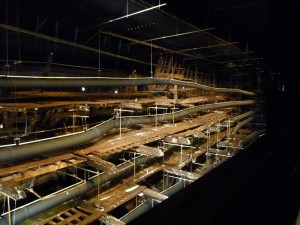
Clare Cherry and her partner, David, visited the new Mary Rose Museum last weekend and Clare has kindly reviewed it for those of us who can’t get there at the moment. I’m so jealous as it sounds like a wonderful day out and I enjoyed my visits to the old museum. Over to Clare…
The Mary Rose was Henry VIII’s flagship, building work having started on her in 1510, shortly after Henry came to the throne. She was launched in July 1511. The ship sank in the Solent on 19th July 1545, not because she was fired upon, but due to pilot error. She remained submerged in the mud, lost and forgotten, until discovered in 1971. At that time it was only known that there was a wreck under the waters, but not that she was the Mary Rose. After years of exploration she was identified by relics brought to the surface, and she was finally brought to the surface herself in 1982. I can vaguely remember seeing the salvage as a child and being disappointed because she just looked like a lump of wet wood! She was taken to Portsmouth where she has been ever since, but a new Mary Rose museum was completed in May 2013, and there she will remain.
Myself and my partner visited the ship on 29th June 2013. The museum is actually part of a massive complex which includes the National Maritime Museum, The Victory (Lord Nelson’s flagship) and The Warrior (the world’s first iron warship). When we visited, there were 14 modern day warships in dock, and it was quite a sight to see The Victory sandwiched between 2 of the most modern and sophisticated warships on earth. It seemed a case of brawn versus beauty, as the yellow of The Victory’s sides conflicted with the grey of the modern ships, and as her glorious masts towered above the funnels and anti-radar towers of the destroyers.
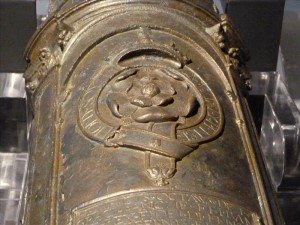
The Mary Rose Museum stands next to The Victory. It is quite a modern looking structure, but has been built to reflect the shape of a ship in which the real ship nestles. You enter the building on the middle level of three, and upon entering, the first exhibit you come across is the ship’s bell, stunningly preserved, closely followed by one of the ship’s cannons clearly identifying Henry’s insignia and the Tudor rose. The cannon had notices surrounding it clearly asking the public not to touch it as the acid on fingers would eventually eat away at the metal work. David and I watched as children and adults alike stroked and prodded the cannon. It was a matter of having to bite down hard on my tongue!
What I found remarkable was the incredible preservation of items found on the ship. Everything from arrows to shoes to medical equipment and musical instruments. As salt preserves wood, we have baskets, buckets and boxes in wonderful condition. Unfortunately salt erodes metal, so although knife handles exist, the blades do not. There are, however, dozens of cannons and hundreds of cannon balls which have survived.
After seeing some of the vast number of exhibits on display you travel through into a viewing platform to see the mid-section of the ship. You travel along a corridor with viewing windows alongside the ship itself. The corridor has been cleverly built to reflect the section of the ship you are viewing, so that although you are allowed nowhere near the ship itself, you feel as if you are actually in it – hard to explain! There are also vast numbers of items on display that would have been in the sections of the ship you are viewing. It is incredibly well done. So clever. All three levels are the same, but give a different aspect of the ship. The actual ship is interlaced with massive pipes which are still drying it out. They do spoil the effect because they do intrude on the overall view, but it can’t be helped. The pipes are there to keep the ship at the correct humidity and are, therefore, essential.
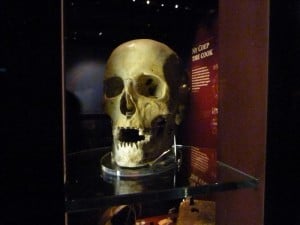 You then travel down to the lowest section where you see the bottom part of the ship. There are further exhibits on every level (14,000 in total), including skulls and a full sized skeleton. At that point I felt a little bit ashamed that in my excitement at seeing the actual ship which had sunk nearly five-hundred years ago, and which had remained submerged for nearly four-hundred and fifty years, I hadn’t given much thought to the poor sailors who had died on her. There were 500 men on board when she sank, and only 35 survived. The Mary Rose really is a memorial to the tragic loss of life.
You then travel down to the lowest section where you see the bottom part of the ship. There are further exhibits on every level (14,000 in total), including skulls and a full sized skeleton. At that point I felt a little bit ashamed that in my excitement at seeing the actual ship which had sunk nearly five-hundred years ago, and which had remained submerged for nearly four-hundred and fifty years, I hadn’t given much thought to the poor sailors who had died on her. There were 500 men on board when she sank, and only 35 survived. The Mary Rose really is a memorial to the tragic loss of life.
From the bottom of the ship you get in a lift which takes you to the top level. This is also extraordinarily well done. The side of the lift is glass and it travels upwards at the front of the ship. As it slowly goes up the lift lights are extinguish so that you get the most incredible view of the whole of the ship from the bow. It was a magical experience. On this level there are about 10 items removed from the ship that you are able to touch and hold. They include an original piece of rope on which you are still able to smell the Tudor tar which it was painted with for protection (very smelly!). Then, after a look of the ship at the top level, where you can see the beams and structure at their best, it’s back down to the middle level and through the requisite gift shop, complete with some of the most expensive mugs on the planet.
We decided not to remortgage the house to buy a mug, and instead had a look at the stunning Victory, before taking a boat trip round the site to see the warships. It was a great day out. The Mary Rose herself is far better preserved than I had thought she would be having seen her brought to the surface all those years ago. But even more impressive were the items found on her. Awe inspiring and poignant at the same time. So I suppose my final words should be, ‘rest in peace to all who died on her’.
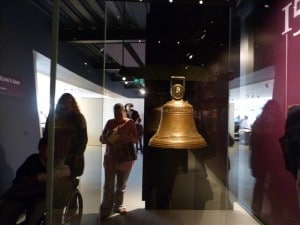
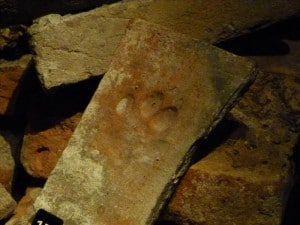
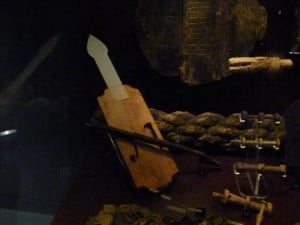
You can find out more about The Mary Rose Museum and information on visiting it at http://www.maryrose.org/
P.S. Thank you to all those who participated in our fundraising efforts for The Mary Rose Museum – look what we were a part of!